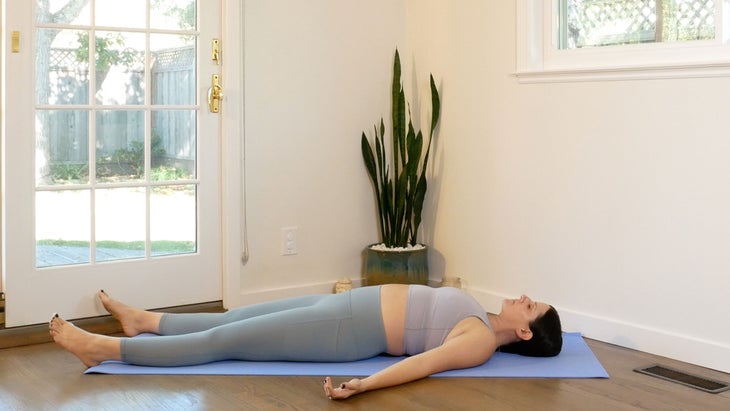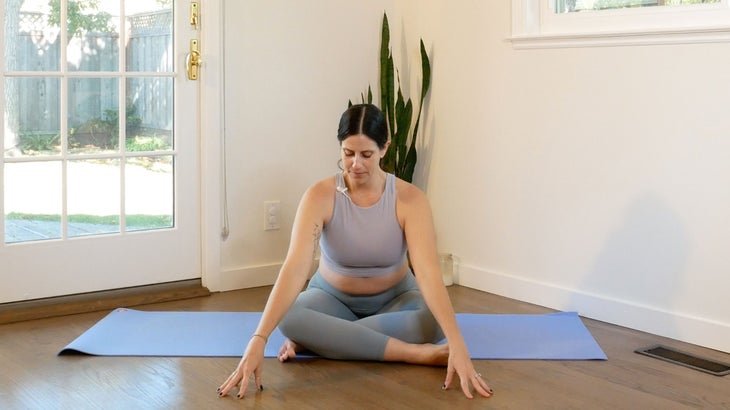“], “filter”: { “nextExceptions”: “img, blockquote, div”, “nextContainsExceptions”: “img, blockquote, a.btn, a.o-button”} }”>
I am married with a toddler and a newborn. Anything longer than a 15-minute yoga flow is, frankly, a luxury.
I’m not alone. Most of us have maybe 20 or 30 minutes to come to the mat on any given day. But because so many of us assume it takes a full hour to do a “complete” flow, we don’t bother. Ironically, this happens on the days when we tend to need yoga the most.
Yet when I come to my mat for even a few minutes, it makes all the difference in my outlook and my day. Let’s debunk the myth that you need a certain amount of time to practice yoga. What if more of us came to our mats more often, if even for less time than we think we need? You may find that even a 15-minute yoga flow is sufficient. It is for me.
See also: 5 Calming Yoga Poses You Can Do In 5 Minutes
A 15-minute yoga flow you can do anytime
Sukhasana (Easy Pose)
Why you need it: Your brain automatically makes associations. Even the simple act of sitting cross-legged on your yoga mat can signal your nervous system that it’s time to relax.
How to: Sit on your mat and cross your legs with your right shin in front of your left, stacking your knees over your ankles in Sukhasana. As you inhale, reach your arms alongside your ears and reach for the ceiling. As you exhale, hinge forward at your hips and lean over your legs to whatever extent is comfortable. You may lean just a few inches ahead or you may place your forehead on a block, the floor, or make a pillow with stacked fists. Stay here for 5 full breaths. Come back up to sitting and switch sides.

Marjaryasana-Bitilasana (Cat-Cow Pose)
Why you need it: Coordinating movement with breath is an almost instantaneous way to draw your awareness into the moment and away from should haves and what ifs. Moving in between Cat and Cow is also a fabulous mini sequence to warm up and release your spine.
How to: From sitting, come to your hands and knees in Tabletop. As you inhale, pull your sternum forward, arch your back, and open your chest into Cow. On your exhale, press your palms into the mat and round your spine in Cat. Repeat as desired.

Adho Mukha Svanasana (Downward-Facing Dog Pose)
Why you need it: Those days when I have time to do just one pose, Downward-Facing Dog is it. Although contrary to what some teachers promise, Down Dog isn’t restful for everybody. If that’s the case for you, it’s worth taking a moment and figuring out which pose would be that “one pose a day” pose for you. Then do it each day.
How to: From hands and knees, curl your toes under, lift your knees off the ground, and press your thighs back, coming into Downward-Facing Dog. Straighten your upper arms and draw them toward your ears. Keep your spine long, which might mean you keep a bend in your knees rather than maintain straight legs, and that’s perfectly fine. Keep the back of your neck long by looking between your legs. Stay here for 10 breaths and feel free to “mindfully fidget” by pedaling your legs or undulating your spine. When you’re ready, walk your feet to the front of the mat and slowly come up to standing.

Surya Namaskar A (Sun Salutation A)
Why you need it: Even one round of Sun A gets you moving and breathing in a rhythmic way. The juxtaposition of opposing movements within the sequence—going between backbends and flat back and forward bends—makes this a full-body experience.
How to: Start in Tadasana (Mountain Pose) at the top of your mat.
On an inhalation, reach your arms up and overhead into Urdhva Hastasana (Upward Salute).
On an exhalation, bend forward and place your palms by your feet or on your outer shins in Uttanasana (Standing Forward Bend).
On an inhalation, reach your chest forward and lift halfway into Ardha Uttanasana (Half Standing Forward Bend).
On an exhalation, either step back to Plank Pose and lower halfway into Chaturanga Dandasana (Four-Limbed Staff Pose) or jump back into Chaturanga Dandasana.
Inhale and lift your chest into Urdhva Mukha Svanasana (Upward-Facing Dog Pose).
On an exhalation, lift your hips up and back to Downward-Facing Dog. Stay here for 5 full breaths. At the end of your fifth breath, hop or step to the top of your mat.
Inhale into Ardha Uttanasana.
Exhale into Uttanasana.
On your inhale, lift your torso coming through Utthita Hastasana and exhale your arms by your sides, back to Tadasana.
Repeat, taking as many rounds as you desire, depending on the amount of time and energy you have.
See also: Got Wrist Pain? Here’s How to Modify Sun Salutation A

Setu Bandha Sarvangasana (Bridge Pose)
Why you need it: Our days are often spent rounded forward. This is the result of gravity as well as working on devices and spending large amounts of time sedentary and sitting. Backbends are not only naturally energizing, but they help retrain your upper chest to open and strengthen your back.
How to: Come onto your back. Separate your feet hip-width and align your knees above your ankles. On an inhale, lift your hips into Bridge Pose. Roll your upper arms underneath you until you are resting on your outer upper arms. Either interlace your fingers beneath you or grab the edges of the mat. Gently press the back of your head into the floor without tucking your chin or jutting it toward the ceiling. Take 8 full breaths. Release your hands and lower down slowly, one vertebra at a time. Feel free to repeat if you like, depending on your time constraints.

Jathara Parivartanasana (Revolved Abdomen Pose | Reclining Twist)
Why you need it: Twists are often thought of as the great neutralizer in yoga and are believed to reset the spine and bring your body back into balance after any extreme movement, including backbends. On an energetic level, there can be a sense of wringing yourself out, as you would a dishcloth.
How to: Still on your back, pull your knees toward your chest or keep your feet resting on the mat. As you exhale, lower your knees over to the right and turn your head toward the left in a reclining twist. Your arms can be wide like a “T” or bent like a cactus. Stay here for at least 5 breaths. Return your knees to center and, as your exhale, twist in the opposite direction. Please note that if you are pregnant or dealing with lower back pain, keeping your feet and knees apart may be a helpful way to accommodate your body and ease the twist.
See also: 8 Yoga Twists (Yes, Twists!) That Actually Ease Back Pain

Savasana (Corpse Pose)
Why you need it: It integrates your entire practice physically and resets you psychologically, as well. Of course, you could always do Savasana for the entire 15 minutes and that would be a phenomenal practice.
How to: Lie on your back and extend your legs straight or keep your knees bent and feet on the floor. Release your arms by your sides. Turn your upper arms, gently tucking your shoulders underneath you, so your palms face skyward. If it feels safe for you, cover your eyes with a towel or eye pillow. Wiggle around until you feel fully settled. Take a deep breath in and out. Simply rest.
Just because it’s a shorter practice does not mean you need to feel rushed in this shape. Stay here for anywhere from 3 to 7 minutes. If you are worried about the time, set an alarm or timer. Or simply let your body tell you when it is ready to release the pose.
When you’re ready to come out of the pose, inhale your arms overhead and reach through your legs. Pull your knees in and pause before you roll to one side and slowly come to Easy Seat. Return to sitting in Sukhasana. Observe that while it may not appear as though much has changed outwardly, a whole lot has shifted for you inwardly.
This article has been updated. Originally published December 1, 2021.
See also: More Short Yoga Practices
About our contributor
Sarah Ezrin is an author, world-renowned yoga educator, popular Instagram influencer, and mama based in the San Francisco Bay Area. Her willingness to be unabashedly honest and vulnerable along with her innate wisdom make her writing, yoga classes, and social media great sources of healing and inner peace for many people. Sarah is changing the world, teaching self-love one person at a time. You can follow her on Instagram at @sarahezrinyoga and TikTok at @sarahezrin.

